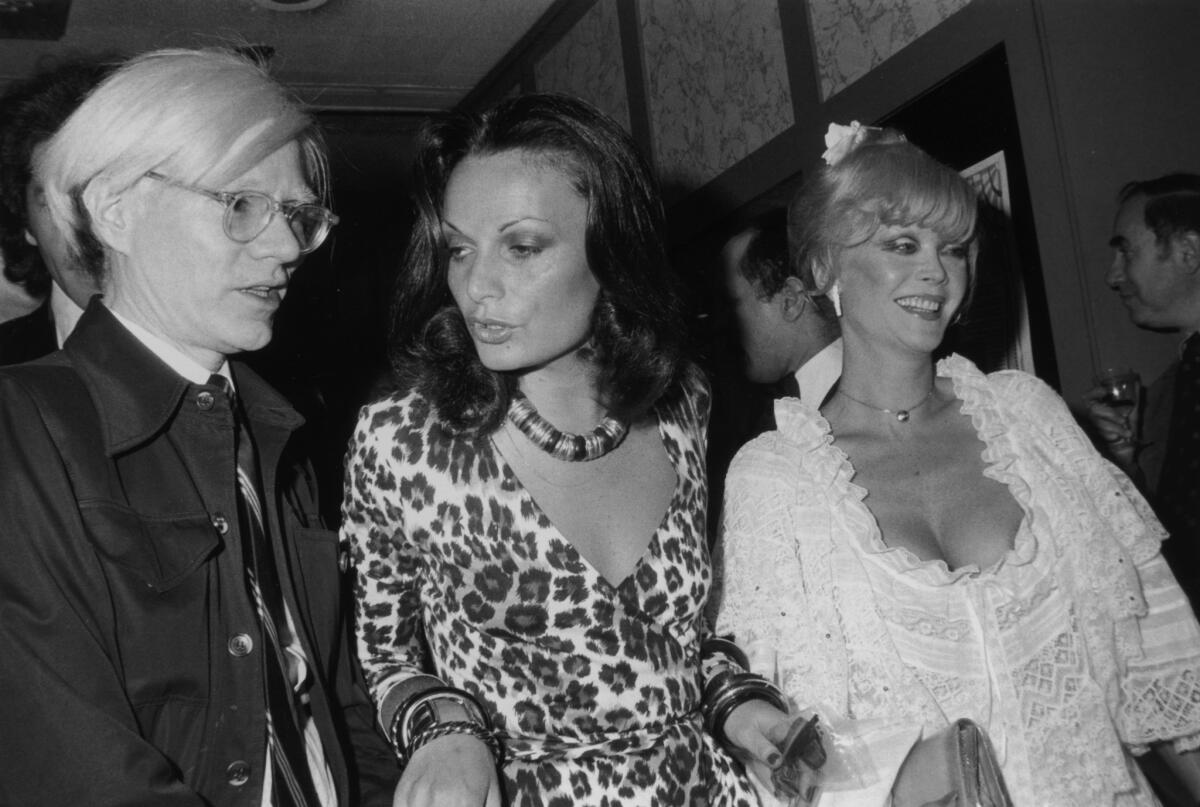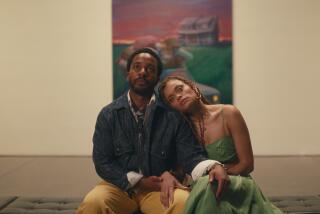From the Archives: Andy Warhol, Pioneer of ‘60s Pop Art, Dies

Andy Warhol, left, Diane von Furstenberg, and Monique Van Vooren.
- Share via
Andy Warhol, the deadpan Peter Pan of Pop Art, died of a heart attack Sunday in a New York hospital. He was 58.
The artist had undergone gall bladder surgery at New York Hospital-Cornell Medical Center on Saturday and was reported in “stable” condition. But his condition suddenly worsened early Sunday.
“Sometime after 5:30 a.m. this morning Mr. Warhol arrested and his private-duty nurse summoned the hospital staff. . . . The (cardiac) arrest team worked for close to an hour on Mr. Warhol but all attempts to revive him failed and he was pronounced dead at 6:31 a.m.,” a hospital spokeswoman said.
Warhol, a frail and diminutive man with a shock of silver-blond hair, was a major pioneer of 1960s Pop Art, but outgrew that role to become a major celebrity.
Sporting dark glasses and a black leather jacket, he became an icon of the lore of that hectic decade as inescapable as Bob Dylan, the Rolling Stones or the Beatles.
Posters made from his flat-out images of commonplace objects like soup cans and Brillo boxes introduced a mass audience to the pleasures of socio-critical irony.
Activity in painting, film and the publication of tape-recorded texts helped foster the idea of the artist as a multimedia performer, entrepreneur and concept-maker, breaking down barriers between fine and popular art and between media-celebrity and the once-esoteric fame of painters and sculptors.
Warhol became noted for pithy aphorisms like, “In the future, everybody will be famous for 15 minutes.”
Employing ordinary commercial imagery so seemingly untransformed that it was widely taken for a humorous hoax, he came to note in the early 1960s with poster-like paintings of Campbell’s soup cans, first shown publicly at Los Angeles’ Ferus Gallery in 1962.
He went on to produce images of everything from Blue-Chip Stamps to dollar bills and Brillo boxes.
Celebrity Portraits
A trademark-image were portraits of celebrities, such as Marilyn Monroe or Elvis Presley, repeating the same photographic face in a checkerboard pattern. The image was made poster-like by its production on a silk-screen device.
Although mainly known as a cool ironist, Warhol leaves a legacy of riveting Expressionist style paintings commenting wordlessly on the violence and tragedy of the time.
Today, connoisseurs of his art regard these images of electric chairs, racial violence and the nauseating absurding of women poisoned by canned tuna as among his most significant art. He often evoked mordant tragedy, as in his image of Jacqueline Kennedy at the funeral of her assassinated husband.
Warhol insisted that he loved the feeling of boredom and that he wanted to “be a machine.” Much of his art was mechanically reproduced and as he came to be better known, he turned the making of works over to assistants in his New York studio, the Factory.
The artist claimed to be dedicated to anonymity. He had a rubber stamp made of his signature and sometimes sent look-alikes in his place to public appearances, claiming they would do just as well as himself.
“I’d prefer to remain a mystery,” he said. “I never give my background and, anyway, I make it all up different every time I’m asked.”
Casual observers regarded such acts as humorous or irritating “put-ons” in the jargon of the time, but they were taken as seriously as holy writ in the art world.
Warhol was widely regarded as the source of the decade’s idea that “Everything is Art” as he went on to produce an important rock group, the Velvet Underground, films, album covers such as that depicting the crotch of a pair of blue jeans with a real zipper for a Rolling Stones album and the gossip magazine Interview.
Boring Movies
Early films, like “Empire,” were galvanically boring exercises consisting of nothing but an eight-hour-long shot of the Empire State Building. When asked to illuminate the subtleties of these films Warhol would explain that he was afraid to turn off the camera because he was just learning how to use it.
Later films, often made in collaboration with director Paul Morrisey, became more accessible and employed stunningly attractive unknowns that Warhol drew from an entourage of characters who hung around the Factory. Warhol called them his “superstars.” They often used outrageous names like “Ultra-Violet” and sometimes included such underground actors as the brilliant Taylor Mead.
Warhol’s best-known film was the cult classic “Chelsea Girls,” which runs 3 1/2 hours on two screens. It includes one scene in which a drugged actor goes berserk and attacks the camera, plus much gritty scatological wit.
When it was suggested to Warhol that such scenes should be cut, he said, “Well if it gets to a place the projectionist doesn’t like, he can just turn down the sound or put his hand over the lens.”
Despite his unassuming demeanor, Warhol had a charismatic personality that acted as a magnet and catalyst for people who were talented, disturbed, or both.
In 1968, one of the artist’s female followers shot him in the chest in the Factory elevator because he was “exercising too much influence” over her life. The shooting, within hours of Sen. Robert F. Kennedy’s assassination in Los Angeles, changed Warhol’s life in that he became more cautious of his associates and frequented more conventional circles.
“I met a lot of people I thought were imaginative and creative, because they were beautiful or different,” he reflected later. “A lot of them turned out to be drug freaks or just plain crazy. Now, I’m afraid to get close to people like that any more. I just watch life like a movie. Movies are better movies than life.”
Objects of Worship
Warhol openly worshiped money, celebrities and fame, acting the role of a street-urchin fan. As years passed, the artist himself gained both celebrity and wealth, although even in a suit or tuxedo he continued to cultivate the rumpled appearance that earned him the sobriquet “Raggedy Andy.”
Locally, his work is included in the collections of both the Los Angeles County Museum of Art and the Museum of Contemporary Art. One of his paintings of dollar bills recently fetched $385,000 at auction.
He was invited to the White House and acted in television commercials. His move to media and jet-set celebrity, coupled with a sense that his art had failed to outlive the spirit of the 1960s, made Warhol increasingly irrelevant in the art world until the recent rise of Post-Modernist art. As Marcel Duchamp acted as a guru to Warhol’s generation, he himself came to be regarded as an archetypal role model by younger artists.
The frank banality of Warhol’s art came to be seen once again as a mirror and criticism of modern society’s mass-produced impersonality. Recent art that sees a lack of originality as a virtue is often aesthetically traceable to Warhol.
Warhol recently resumed creating works for some favored organizations, such as the Save the Children campaign, and he was scheduled to appear Friday at an awards ceremony for socially conscious corporations.
He was born Andy Warhola in Pittsburgh, Pa., on Aug. 6, 1927, one of three sons of Czech immigrants. After attending Carnegie Institute of Technology (now Carnegie-Mellon University) in Pittsburg, he moved to New York in 1949, where he lived in a basement apartment on 103rd Street with a mixed group of young men and women, all of whom had artistic ambitions in dance, theater or art.
Warhol, although young and scruffy, had skill as a commercial artist and drew for such fashionable publications as Glamour, Vogue and Harpers Bazaar, specializing in drawings of shoes. His earliest attempts at fine art came from taking literally the advice of an art teacher who said he should paint things he really liked. Since Warhol liked ordinary things—like comic strips, canned food and soft drinks—he painted them.
Tells of Experience
“I’d been eating soup for lunch for 20 years, so I painted it,” he explained.
Warhol is survived by two brothers who still live in the Pittsburgh area. However, both John and Paul Warhola declined to comment on the death of their brother. Funeral arrangements were incomplete.
His first cousin, Michael Warhola of Pittsburgh, remembered Warhol fondly:
“He was always painting when he was a kid,” he told United Press International. “He was very nice, pleasant. He was sickly when he was a kid. He was a regular kid. That’s all.”
Looking at the 1945 Schenley High School yearbook Sunday, he said it showed a picture of a young, blond Andy, with a caption reading, “Andrew ‘Andy’ Warhol, ‘as genuine as a fingerprint.’ ”
Fellow pop artist Julian Schnabel, whose early work was influenced by Warhol, called his death “a tragedy.”
“He was absolutely one of the greatest we ever had in this country,” Schnabel told the wire service.
Schnabel said he visited Warhol’s studio last week and was overwhelmed by his latest works, which included paintings of the Last Supper. “One was about 36 feet long,” he said. “The image was repeated about 50 times.”
“In about 30 years, you’ll see how really important his work is,” Schnabel said. “As important as you think his work is now, it will be more important later. He was so, so far ahead of everybody else.”
Affection for Ordinary
The secret of Warhol’s attraction probably lay in his frank affection for the ordinary, his fundamental shyness and a kind of enigmatic candor. He appealed as much to street people as to aesthetes.
In 1975, he came to Los Angeles to autograph his autobiography, “Andy Warhol from A to B.” Fans beleaguered him at a Hollywood bookstore, where he cheerfully autographed anything they wanted, including a girl’s chest. They called the epicene little man St. Andy.
Asked how he felt about that, he said, “I think they are making fun of me.”
Later, chatting with a journalist about bitter New York winters, Warhol said, “They don’t bother me. I wear panty hose.”
From the Archives: Jazz Great Thelonious Monk Dies
From the Archives: Princess Margaret, 71; Sister of the Queen
From the Archives: Renowed Jazz Bassist Charles Mingus Dies at 56
From the Archives: Beat Generation’s Jack Kerouac Dies at 47
From the Archives: Novelist Ernest Hemingway Dies of Gun Wounds
More to Read
Start your day right
Sign up for Essential California for the L.A. Times biggest news, features and recommendations in your inbox six days a week.
You may occasionally receive promotional content from the Los Angeles Times.






